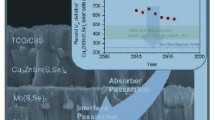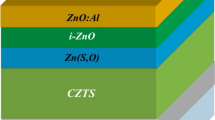Abstract
This research paper consists of a numerical simulation, where we studied the performance of a solar cell with a double-absorber layer. The materials used in this work are similar kesterites based on Cu2FeSnS4 (CFTS) and Cu2BaSnS4 (CBTS), where CFTS is the main absorber with Eg = 1.5 eV, and CBTS is the extra absorber with Eg = 1.9 eV. The use of both materials to absorb light in the proposed solar cell was very beneficial for photovoltaic performance. The study was mainly done on the different parameters and properties of the solar cell, such as thicknesses, concentrations of do**, and resistances. As a result, the proposed structure has great outputs. It offers 1.48 V, 28.26 mA/cm2, 82.68, and 34.65% for Voc, Jsc, FF, and ƞ, respectively.








Similar content being viewed by others
Change history
03 May 2024
A Correction to this paper has been published: https://doi.org/10.1007/s12596-024-01849-3
Abbreviations
- CFTS (Cu2FeSnS4):
-
Copper iron tin sulfur
- PCE (ɳ(%)):
-
Power conversion efficiency
- CdS:
-
Cadmium sulfide
- FF (%):
-
Fill factor
- ITO:
-
Indium tin oxide
- SC:
-
Solar cell
- CBTS (Cu2BaSnS4):
-
Copper barium tin sulfide
- E g :
-
Band gap energy
- µ n (cm2/vs):
-
Electron mobility
- V oc (V):
-
Open-circuit voltage
- µ p (cm2/vs):
-
Hole mobility
- J sc (mA/cm2):
-
Short-circuit current density
- \({N}_{{\text{D}}}\) (cm− 3):
-
Donor’s concentration
- Q e (%):
-
Quantum efficiency
- \({N}_{{\text{A}}}\)(cm− 3):
-
Shallow uniform acceptor density
- E g (eV):
-
Band gap
- V e /h (cm/s):
-
Thermal velocity of electron/Hole
- χ (eV):
-
Electron affinity
- Nt (cm− 3):
-
Defect density
- ε r :
-
Dielectric permittivity (relative)
- \(\varphi ({\text{ev}})\) :
-
Contact work function
- N c (cm− 3):
-
CB effective density of states
- Se (cm/s):
-
Electrons surface recombination velocity
- N v (cm− 3):
-
VB effective density of states
- Sh (cm/s):
-
Surface recombination velocity for holes
References
L.S.I. De Montoya, H.J. Cortina-Marrero, M.A. Ruíz-Sánchez, L. Hechavarría-Difur, F.J. Sánchez-Rodríguez, M. Courel, H. Hu, Optimization of CH3NH3PbI3 perovskite solar cells: A theoretical and experimental study. Sol. Energy 199, 198–205 (2020). https://doi.org/10.1016/j.solener.2020.02.026
T. Chargui, F. Lmai, M. Al-Hattab, O. Bajjou, K. Rahmani, Experimental and numerical study of the CIGS/CdS heterojunction solar cell. Opt. Mater. 140, 113849 (2023). https://doi.org/10.1016/j.optmat.2023.113849
X. Zhao, H.Q. Tan, E. Birgersson, H. Xue, Elucidating the underlying physics in a two-terminal all-perovskite tandem solar cell: A guideline towards 30% power conversion efficiency. Sol. Energy 231, 716–731 (2022). https://doi.org/10.1016/j.solener.2021.11.029
J. Guerroum, M. Al-Hattab, Y. Chrafih, L. Moudou, K. Rahmani, Y. Lachtioui, O. Bajjou, Ag2BeSnX4(S, Se, Te)-based kesterite solar cell modeling: A D F T investigation and S c a p s - 1 d analysis. Sol. Energy 266, 112194 (2023). https://doi.org/10.1016/j.solener.2023.112194
M. Al-Hattab, Y. Chrafih, E. Oublal, M. Sahal, L. Moudou, O. Bajjou, K. Rahmani, Ab initio investigation for solar technology on the optical and electronic properties of double perovskites Cs 2 AgBiX 6 (X=Cl, Br, I). ECS J. Solid State Sci. Technol. 12, 094004 (2023). https://doi.org/10.1149/2162-8777/acf7ed
M. Al-Hattab, E. Oublal, Y. Chrafih, L. Moudou, O. Bajjou, M. Sahal, K. Rahmani, Novel simulation and efficiency enhancement of eco-friendly Cu2FeSnS4/c-silicon tandem solar device. SILICON (2023). https://doi.org/10.1007/s12633-023-02582-5
H. Guan, H. Shen, B. Jiao, X. Wang, Structural and optical properties of Cu2FeSnS4 thin film synthesized via a simple chemical method. Mater. Sci. Semicond. Process. 25, 159–162 (2014). https://doi.org/10.1016/j.mssp.2013.10.021
F. Ozel, Earth-abundant quaternary semiconductor Cu 2 MSnS 4 (M = Fe Co, Ni and Mn) nanofibers: Fabrication, characterization and band gap arrangement. J. Alloys Compd. 657, 157–162 (2016). https://doi.org/10.1016/j.jallcom.2015.10.087
D. Shin, T. Zhu, X. Huang, O. Gunawan, V. Blum, D.B. Mitzi, Earth-abundant chalcogenide photovoltaic devices with over 5% efficiency based on a Cu 2 BaSn(S, Se) 4 absorber. Adv. Mater. 29, 1606945 (2017). https://doi.org/10.1002/adma.201606945
J. Ge, P. Koirala, C.R. Grice, P.J. Roland, Y. Yu, X. Tan, R.J. Ellingson, R.W. Collins, Y. Yan, Oxygenated CdS buffer layers enabling high open-circuit voltages in earth-abundant Cu 2 BaSnS 4 thin-film solar cells. Adv. Energy Mater. 7, 1601803 (2017). https://doi.org/10.1002/aenm.201601803
A. Ghobadi, M. Yousefi, M. Minbashi, A.H.A. Kordbacheh, A.R.H. Abdolvahab, N.E. Gorji, Simulating the effect of adding BSF layers on Cu2BaSnSSe3 thin film solar cells. Opt. Mater. 107, 109927 (2020). https://doi.org/10.1016/j.optmat.2020.109927
R.K. Zahoo, Effect of carrier concentration and thickness of absorber layer on performance CBTS solar cell. Turk. J. Comput. Math. Educ. TURCOMAT 12, 5056–5064 (2021). https://doi.org/10.17762/turcomat.v12i10.5281
H.T. Ghanem, A.N. Saleh, M.A. Kamil, Simulation and improvement of the efficiency of the CFTS solar cell using SCAPS-1D, karbala Int. J. Mod. Sci. 8, 63–70 (2022). https://doi.org/10.33640/2405-609X.3207
M. Al-Hattab, E. Oublal, M. Sahal, L. Moudou, O. Bajjou, K. Rahmani, Simulation study of the novel Ag2MgSn(S/Se)4 chalcogenide tandem solar device employing monolithically integrated (2T) configurations. Sol. Energy 248, 221–229 (2022). https://doi.org/10.1016/j.solener.2022.11.024
C. Nefzi, M. Souli, Y. Cuminal, N. Kamoun-Turki, Effect of sulfur concentration on structural, optical and electrical properties of Cu2FeSnS4 thin films for solar cells and photocatalysis applications. Superlattices Microstruct. 124, 17–29 (2018). https://doi.org/10.1016/j.spmi.2018.09.033
E. Oublal, A. Ait Abdelkadir, M. Sahal, High performance of a new solar cell based on carbon nanotubes with CBTS compound as BSF using SCAPS-1D software. J. Nanoparticle Res. 24, 202 (2022). https://doi.org/10.1007/s11051-022-05580-7
F.K. Konan, H.T. Nkuissi, B. Hartiti, Numerical simulations of highly efficient Cu2FeSnS4 (CFTS)-based solar cells. Int. J. Renew. Energy Res. (2019). https://doi.org/10.20508/ijrer.v9i4.9816.g7829
S. Madani, T. Tesfamichael, H. Wang, N. Motta, Study of Pb-based and Pb-free perovskite solar cells using Cu-doped Ni1-xO thin films as hole transport material. Ceram. Int. 48, 15207–15217 (2022). https://doi.org/10.1016/j.ceramint.2022.02.051
H. Abnavi, D.K. Maram, A. Abnavi, Performance analysis of several electron/hole transport layers in thin film MAPbI3-based perovskite solar cells: A simulation study. Opt. Mater. 118, 111258 (2021). https://doi.org/10.1016/j.optmat.2021.111258
V.C. Karade, J.S. Jang, D. Kumbhar, M. Rao, P.S. Pawar, S. Kim, K.S. Gour, J. Park, J. Heo, T.D. Dongale, J.H. Kim, Combating open circuit voltage loss in Sb2Se3 solar cell with an application of SnS as a back surface field layer. Sol. Energy 233, 435–445 (2022). https://doi.org/10.1016/j.solener.2022.01.010
K. Fatema, M.S. Arefin, Enhancing the efficiency of Pb-based and Sn-based perovskite solar cell by applying different ETL and HTL using SCAPS-ID. Opt. Mater. 125, 112036 (2022). https://doi.org/10.1016/j.optmat.2022.112036
M. Cai, N. Ishida, X. Li, X. Yang, T. Noda, Y. Wu, F. **e, H. Naito, D. Fujita, L. Han, Control of electrical potential distribution for high-performance perovskite solar cells. Joule 2, 296–306 (2018). https://doi.org/10.1016/j.joule.2017.11.015
O. Bajjou, M. Al-Hattab, A. Najim, L. Moulaoui, A. Bakour, K. Rahmani, Modeling and simulation of a solar cell based on CIGS/CdS/ZnO, In: 2022 2nd Int. Conf. Innov. Res. Appl. Sci. Eng. Technol. IRASET, IEEE, Meknes, Morocco, 2022: pp. 1–5. https://doi.org/10.1109/IRASET52964.2022.9737875
M. Al-Hattab, L. Moudou, L. Moulaoui, Y. Chrafih, A. Najim, M. Khenfouch, O. Bajjou, K. Rahmani, Numerical Simulation of CdS/GaSe Solar Cell Using SCAPs Simulation Software, in Recent Adv Fuzzy Sets Theory Fract Calc Dyn Syst Optim. ed. by S. Melliani, O. Castillo (Springer, Cham, 2023), pp.315–325. https://doi.org/10.1007/978-3-031-12416-7_27
J. Chen, N. Park, Causes and solutions of recombination in perovskite solar cells. Adv. Mater. 31, 1803019 (2019). https://doi.org/10.1002/adma.201803019
E. Oublal, M. Al-Hattab, A. Ait Abdelkadir, M. Sahal, New numerical model for a 2T-tandem solar cell device with narrow band gap SWCNTs reaching efficiency around 35 %. Sol. Energy 246, 57–65 (2022). https://doi.org/10.1016/j.solener.2022.09.036
L.K. Ono, S. Frank Liu, Y. Qi, Reducing detrimental defects for high-performance metal halide perovskite solar cells. Angew. Chem. Int. Ed. 59, 6676–6698 (2020). https://doi.org/10.1002/anie.201905521
F. Baig, Mitigation of interface recombination by careful selection of ETL for efficiency enhancement of MASnI3 solar cell. Optik 170, 463 (2018)
M. Moustafa, T. Al Zoubi, S. Yasin, Exploration of CZTS-based solar using the ZrS2 as a novel buffer layer by SCAPS simulation. Opt. Mater. 124, 112001 (2022). https://doi.org/10.1016/j.optmat.2022.112001
Y. Chrafih, M. Al-Hattab, K. Rahmani, Thermodynamic, optical, and morphological studies of the Cs2AgBiX6 double perovskites (X = Cl, Br, and I): Insights from DFT study. J. Alloys Compd. 960, 170650 (2023). https://doi.org/10.1016/j.jallcom.2023.170650
M.A. Shafi, L. Khan, S. Ullah, M.Y. Shafi, A. Bouich, H. Ullah, B. Mari, Novel compositional engineering for ~26% efficient CZTS-perovskite tandem solar cell. Optik 253, 168568 (2022). https://doi.org/10.1016/j.ijleo.2022.168568
Acknowledgements
The authors would like to thank Mr. Marc Burgelman for ensuring that \(SCAPS-1D\) software was available.
Author information
Authors and Affiliations
Corresponding authors
Additional information
Publisher's Note
Springer Nature remains neutral with regard to jurisdictional claims in published maps and institutional affiliations.
Rights and permissions
Springer Nature or its licensor (e.g. a society or other partner) holds exclusive rights to this article under a publishing agreement with the author(s) or other rightsholder(s); author self-archiving of the accepted manuscript version of this article is solely governed by the terms of such publishing agreement and applicable law.
About this article
Cite this article
Oublal, E., Al-Hattab, M., Ait Abdelkadir, A. et al. Cu2BaSnS4/Cu2FeSnS4 combination for a good light absorption in thin-film solar cells—a numerical model. J Opt (2024). https://doi.org/10.1007/s12596-024-01667-7
Received:
Accepted:
Published:
DOI: https://doi.org/10.1007/s12596-024-01667-7




